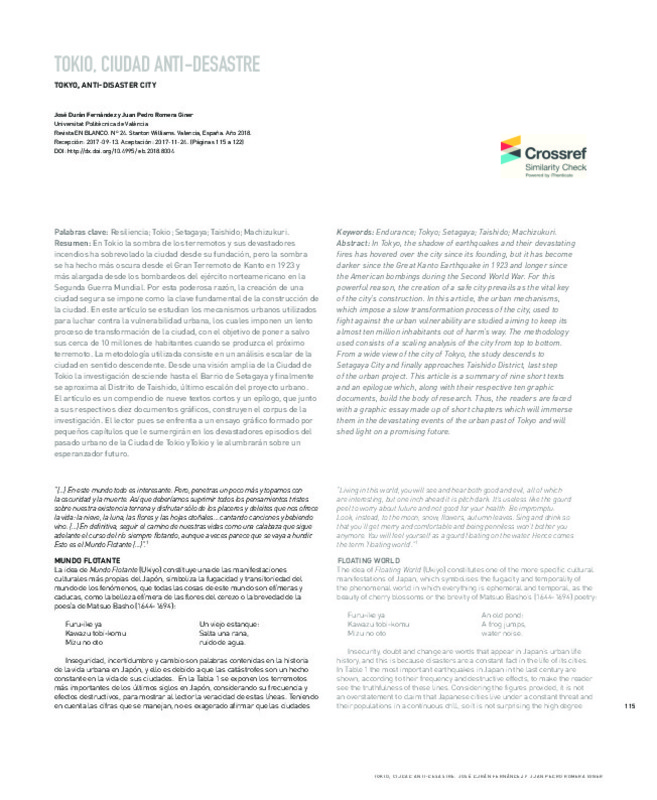|
Resumen:
|
[EN] In Tokyo, the shadow of earthquakes and their devastating fires has hovered over the city since its founding, but it has become darker since the Great Kanto Earthquake in 1923 and longer since the American bombings ...[+]
[EN] In Tokyo, the shadow of earthquakes and their devastating fires has hovered over the city since its founding, but it has become darker since the Great Kanto Earthquake in 1923 and longer since the American bombings during the Second World War. For this powerful reason, the creation of a safe city prevails as the vital key of the city's construction. In this article, the urban mechanisms, which impose a slow transformation process of the city, used to fight against the urban vulnerability are studied aiming to keep its almost ten million inhabitants out of harm’s way.
The methodology used consists of a scaling analysis of the city from top to bottom. From a wide view of the city of Tokyo, the study descends to Setagaya City and finally approaches Taishido District, last step of the urban project.
This article is a summary of nine short texts and an epilogue which, along with their respective ten graphic documents, build the body of research. Thus, the readers are faced with a graphic essay made up of short chapters which will immerse them in the devastating events of the urban past of Tokyo and will shed light on a promising future.
[-]
[ES] En Tokio la sombra de los terremotos y sus devastadores incendios ha sobrevolado la ciudad desde su fundación, pero la sombra se ha hecho más oscura desde el Gran Terremoto de Kanto en 1923 y más alargada desde los ...[+]
[ES] En Tokio la sombra de los terremotos y sus devastadores incendios ha sobrevolado la ciudad desde su fundación, pero la sombra se ha hecho más oscura desde el Gran Terremoto de Kanto en 1923 y más alargada desde los bombardeos del ejército norteamericano en la Segunda Guerra Mundial. Por esta poderosa razón, la creación de una ciudad segura se impone como la clave fundamental de la construcción de la ciudad. En este artículo se estudian los mecanismos urbanos utilizados para luchar contra la vulnerabilidad urbana, los cuales imponen un lento proceso de transformación de la ciudad, con el objetivo de poner a salvo sus cerca de 10 millones de habitantes cuando se produzca el próximo terremoto.
La metodología utilizada consiste en un análisis escalar de la ciudad en sentido descendente. Desde una visión amplia de la Ciudad de Tokio la investigación desciende hasta el Barrio de Setagaya y finalmente se aproxima al Distrito de Taishido, último escalón del proyecto urbano.
El artículo es un compendio de nueve textos cortos y un epílogo, que junto a sus respectivos diez documentos gráficos, construyen el corpus de la investigación. El lector pues se enfrenta a un ensayo gráfico formado por pequeños capítulos que le sumergirán en los devastadores episodios del pasado urbano de la Ciudad de Tokio y le alumbrarán sobre un esperanzador futuro.
[-]
|









